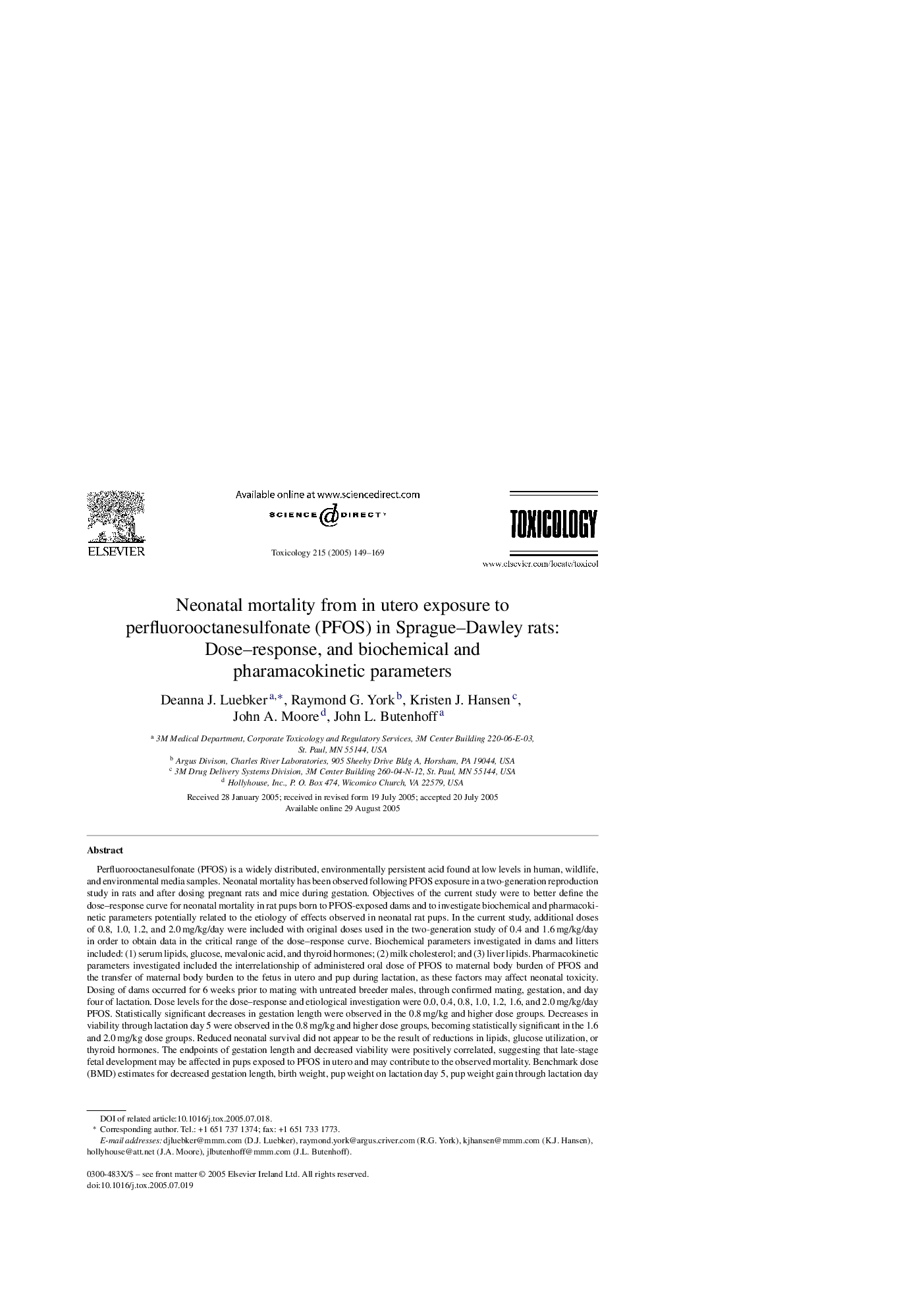| کد مقاله | کد نشریه | سال انتشار | مقاله انگلیسی | نسخه تمام متن |
|---|---|---|---|---|
| 9034527 | 1562441 | 2005 | 21 صفحه PDF | دانلود رایگان |
عنوان انگلیسی مقاله ISI
Neonatal mortality from in utero exposure to perfluorooctanesulfonate (PFOS) in Sprague-Dawley rats: Dose-response, and biochemical and pharamacokinetic parameters
دانلود مقاله + سفارش ترجمه
دانلود مقاله ISI انگلیسی
رایگان برای ایرانیان
کلمات کلیدی
موضوعات مرتبط
علوم زیستی و بیوفناوری
علوم محیط زیست
بهداشت، سم شناسی و جهش زایی
پیش نمایش صفحه اول مقاله

چکیده انگلیسی
Perfluorooctanesulfonate (PFOS) is a widely distributed, environmentally persistent acid found at low levels in human, wildlife, and environmental media samples. Neonatal mortality has been observed following PFOS exposure in a two-generation reproduction study in rats and after dosing pregnant rats and mice during gestation. Objectives of the current study were to better define the dose-response curve for neonatal mortality in rat pups born to PFOS-exposed dams and to investigate biochemical and pharmacokinetic parameters potentially related to the etiology of effects observed in neonatal rat pups. In the current study, additional doses of 0.8, 1.0, 1.2, and 2.0Â mg/kg/day were included with original doses used in the two-generation study of 0.4 and 1.6Â mg/kg/day in order to obtain data in the critical range of the dose-response curve. Biochemical parameters investigated in dams and litters included: (1) serum lipids, glucose, mevalonic acid, and thyroid hormones; (2) milk cholesterol; and (3) liver lipids. Pharmacokinetic parameters investigated included the interrelationship of administered oral dose of PFOS to maternal body burden of PFOS and the transfer of maternal body burden to the fetus in utero and pup during lactation, as these factors may affect neonatal toxicity. Dosing of dams occurred for 6 weeks prior to mating with untreated breeder males, through confirmed mating, gestation, and day four of lactation. Dose levels for the dose-response and etiological investigation were 0.0, 0.4, 0.8, 1.0, 1.2, 1.6, and 2.0Â mg/kg/day PFOS. Statistically significant decreases in gestation length were observed in the 0.8Â mg/kg and higher dose groups. Decreases in viability through lactation day 5 were observed in the 0.8Â mg/kg and higher dose groups, becoming statistically significant in the 1.6 and 2.0Â mg/kg dose groups. Reduced neonatal survival did not appear to be the result of reductions in lipids, glucose utilization, or thyroid hormones. The endpoints of gestation length and decreased viability were positively correlated, suggesting that late-stage fetal development may be affected in pups exposed to PFOS in utero and may contribute to the observed mortality. Benchmark dose (BMD) estimates for decreased gestation length, birth weight, pup weight on lactation day 5, pup weight gain through lactation day 5, and viability resulted in values ranging from 0.27 to 0.89Â mg/kg/day for the lower 95% confidence limit of the BMD5 (BMDL5). Results of analyses for PFOS in biological matrices indicate a linear proportionality of mean serum PFOS concentration to maternal administered dose prior to mating and through the first two trimesters of gestation. However, at 21 days of gestation, mean serum PFOS concentrations were notably reduced from values measured earlier in gestation. Urinary and fecal elimination was low as expected from prior observations in adult rats. Significant transfer of PFOS from dam to fetus in utero was confirmed, and results suggest that dam and corresponding fetal body burdens, as indicated by serum and liver PFOS levels, correlate with neonatal survival.
ناشر
Database: Elsevier - ScienceDirect (ساینس دایرکت)
Journal: Toxicology - Volume 215, Issues 1â2, 5 November 2005, Pages 149-169
Journal: Toxicology - Volume 215, Issues 1â2, 5 November 2005, Pages 149-169
نویسندگان
Deanna J. Luebker, Raymond G. York, Kristen J. Hansen, John A. Moore, John L. Butenhoff,